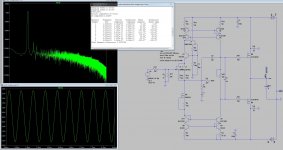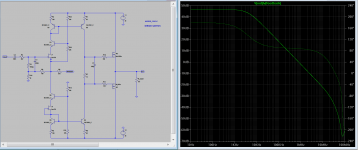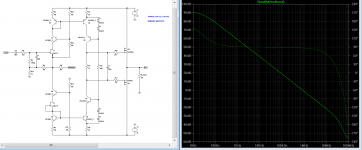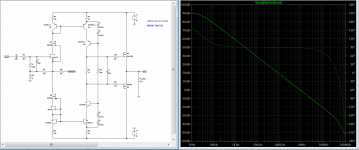The mirror was taken over from the Nobrainer, a rather simple design that works but does not have any aspiration to be particular good.
I used the mirror because it works.
That is maybe an unsatifying explanation but it is what it is.
Then the mirror was improved twice, first by Frans and then by Michael.
The design has mutated so much that i can understand why the mirror is questioned now.
When you really want tight bass you need more feedback.
Under this premiss it may be a good idea to use a different VAS, even without the mirror when that gives more open loop gain.
Now we are talking!
Why do we have more open loop gain with the mirror ?
The Circle has more than 70 dB open-loop gain.
Extremely good distortion distribution and the absolute beauty of Pass simplicity.
It's really a summation of this thread, Sergio's eye for simplicity and Gerhard's widespread use of mirrors. To be Honest I am quite stunned with the results it produces, and I really like the fact that everything is in a circle. Only issue is the different gender-HFE's of the mirror transistors, this produces a little offset. A servo may be needed due the thermals. it's possible that it will be sufficient to adjust the offset by trimming one of the mirror transistors.
Miib, You just made it perfectly clear now and the choice is done.... The Circle will be my next amp.... 🙂
Well, maybe we have LESS open loop gain with the mirrors against alternatives.
The advantages of the mirror are good shielding from the PSU and when you make it really stiff only voltage is transfered and no current. So that holds one performance parameter steady, actually eroding current transfer distortion by loading the VAS with a high impedance CCS.
The VAS has to drive the input capacitance of the LatFets though.
The advantages of the mirror are good shielding from the PSU and when you make it really stiff only voltage is transfered and no current. So that holds one performance parameter steady, actually eroding current transfer distortion by loading the VAS with a high impedance CCS.
The VAS has to drive the input capacitance of the LatFets though.
Well, in MIIBs design the VAS is loaded with a high impedance too and you do not loose the voltage required to make the mirror work.
That can be easy transfered into a parallel symmetric design.
Ok, it will cancel second harmonic mostly.
Ok, it will cancel second harmonic mostly.
You could also do an output inclusive compensation by spitting C9 between the VAS and the output, resistor in between to ground.
I figured, either you loose 1 mA driving the cascodes or you loose fractions of mA's of base current. the balance is quite tricky, this simulates better, the other may sound better.
I think the beauty of this design is the single ended part that leaves room for the floating CCS, making it symmetric will take that and the circle out.
I think the beauty of this design is the single ended part that leaves room for the floating CCS, making it symmetric will take that and the circle out.
Last edited:
Adding a cascode to the VAS stage , permit to have a more linear vas stage and a big increase in open loop gain, at least at the low frequencies, That bring promises of a more controlled bass. Once again is no need for miller compensation.
Attachments
R25 should be a CCS.
Yes, or it can be use a depletion mosfet like this.
Attachments
Ricardo, congratulations for finishing your amplifier.
One thing that you can improve, is the fact that as you use the power supply far way from the amplifier board, you have to put reservoir capacitors (10000uf will be good) near the amplifier board to prevent the rectified class B currents from circulating in such a big loop, this capacitors will make this nasty currents circulate in a tight loop near the amplifier, keep the plus, minus and ground wires together also helps to prevent this currents from radiate.
One thing that is very important and I dont see it in the photo you take is the safety ground. That is very important , as a faulty transformer can make the amplifier case connected to the HV line , and that can be deadly.
One thing that you can improve, is the fact that as you use the power supply far way from the amplifier board, you have to put reservoir capacitors (10000uf will be good) near the amplifier board to prevent the rectified class B currents from circulating in such a big loop, this capacitors will make this nasty currents circulate in a tight loop near the amplifier, keep the plus, minus and ground wires together also helps to prevent this currents from radiate.
One thing that is very important and I dont see it in the photo you take is the safety ground. That is very important , as a faulty transformer can make the amplifier case connected to the HV line , and that can be deadly.
Last edited:
I like 393 in principle. The phase margin looks really good and the depletion Fet is a simplification without performance loss.
This circuits are interesting. If i have time tomorrow will try with a complementary pair at input 2sk170/j74. As i am in love with this pair 🙂.
Pity that is not possible to use tmc compensation (at least without adding another stage to the amp), it would be of great help with this lateral mosfets.
Pity that is not possible to use tmc compensation (at least without adding another stage to the amp), it would be of great help with this lateral mosfets.
I like 393 in principle. The phase margin looks really good and the depletion Fet is a simplification without performance loss.
One thing that I forget is adding some gate resistors on those depletion mosfets, to prevent any tendency to hf instability. Phase margin are indeed good, and that is mainly because the output stage is so simple and the vas stage is very fast thanks to the cascode circuit.
I really like the depletion cascode, as it keeps the circle intact and removes the base-current issue.
The driven VAS cascode is dubious and has no better result than the double mirror, the VAS cascode has a HF resonance at a few MHz.
This is a beautiful simple creature, Flexible as a gain-cell scale-able in size and with the possibility to drive a full range of OPS, it can be downscaled and work as a superb line-stage as well.
The driven VAS cascode is dubious and has no better result than the double mirror, the VAS cascode has a HF resonance at a few MHz.
This is a beautiful simple creature, Flexible as a gain-cell scale-able in size and with the possibility to drive a full range of OPS, it can be downscaled and work as a superb line-stage as well.
- Home
- Amplifiers
- Solid State
- Assemblage Power Amp



